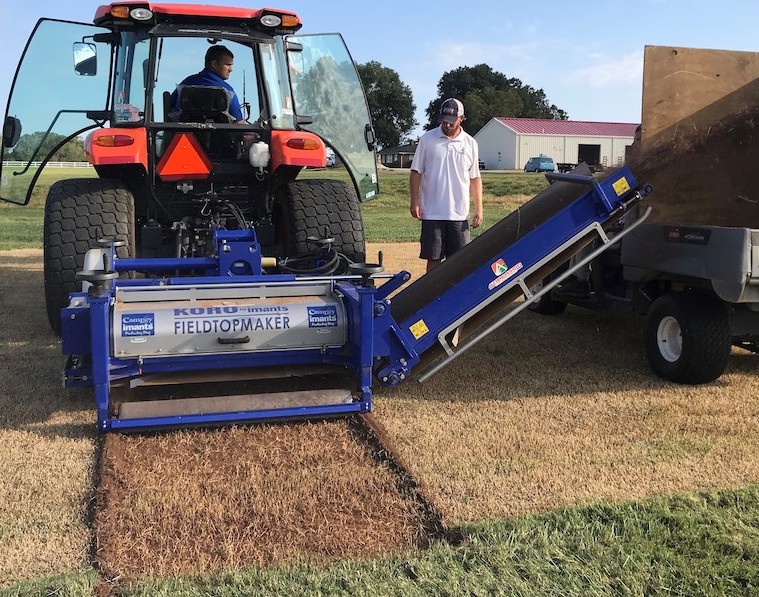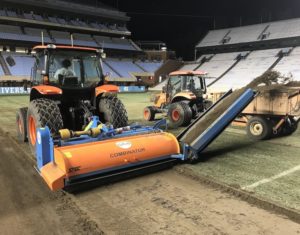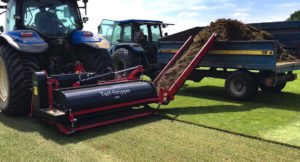By Ray McCauley, Ph.D.
Bermudagrass is the turfgrass of choice for sports fields in the southern United States because of its excellent quality, stress tolerances, and rapid growth rate. However, bermudagrass can produce excessive thatch – a layer of living and dead plant material that forms between the green turfgrass shoots and the soil surface.
At moderate depths (< 0.5-inch), thatch protects turfgrass crowns from traffic, moderates soil temperatures, and provides cushioning for falling athletes. However, turfgrass health and aesthetics, as well as soil physical properties (how fields behave) are compromised when thatch exceeds 0.5-inch depth. Excessive thatch reduces drought tolerance, increases localized dry spot potential, and slows water, air, fertilizer and pesticide movement into the soil. Excess thatch also increases the likelihood of winterkill and spring dead spot.
Sports field managers often employ various cultural practices to manage thatch. Topdressing – the broadcasting of a thin layer of sand or soil across the field – is the best cultural practice for controlling thatch accumulation (Beard, 1973; Miller, 2008). To be effective, though, topdressing must be performed multiple times annually. If thatch levels become excessive, topdressing alone becomes ineffective. Instead, mechanical practices must be used. These practices are often laborious, expensive and disruptive of turfgrass quality. Hollow-tine aerification and vertical mowing have been the standard mechanical practices used to manage thatch. Although their aggressiveness may be adjusted, neither aerification nor vertical mowing impacts the entire surface, and multiple years of both are often necessary to effectively manage thatch.
Fraise mowing
Fraise mowing is a highly disruptive mechanical practice that is not for the faint of heart. It enables sports field managers to (potentially) remove all thatch without the added time and expenses of gradual thatch reduction. Like other cultural practices, fraise mowing has collateral effects on bermudagrass quality and soil physical properties, which can last for weeks to months. However, these effects and duration can be manipulated. Beginning in May 2016, several studies were conducted to evaluate the influences of fraise mowing. Several of these studies were conducted on athletic fields in the piedmont region of North Carolina.
Fraise mowing produces an unsightly (often bare ground) surface for ≥3 weeks until bermudagrass recovers. This downtime decreases facility revenues, and should be as short as possible. Fraise mowing timing is imperative to limit this downtime. Bermudagrass does not begin aggressively growing until daytime and nighttime air temperatures exceed 85°F and 65°F, respectively, for more than one week. If fraise mowing is performed too early in the growing season, the cooler temperatures will slow bermudagrass recovery. This was evident in North Carolina when slower recovery occurred following fraise mowing at 0.5-inch depth in mid May (6 weeks recovery) compared to mid June (4 weeks recovery). Caution should be exercised when fraise mowing in the late summer, as well. Bermudagrass goes off-color/dormant after the first killing frost, but its growth typically slows well before (≥1 month) this date. If bermudagrass is fraise mowed too late (and too aggressively) in the late summer, bermudagrass decline or death, as well as increased winter weed pressure may result (Stewart et al., 2016). Therefore, give your bermudagrass fields ample time to recover by timing fraise mowing in the late spring to mid-summer.
The old adage “garbage in, garbage-out” holds true with fraise mowing. If a field has poor coverage before fraise mowing, bermudagrass will not spontaneously appear after fraise mowing. Instead, bare areas will persist. If bare areas (without any stolons or rhizomes) >1 foot in diameter are present after fraise mowing, they should be sprigged, plugged or sodded to speed up recovery.
Fraise mowing depth has a profound effect on bermudagrass recovery. Bermudagrass recovers from growing points where new shoots emerge (nodes) on unmown rhizomes and stolons. As fraise mowing cutting depths increase, more nodes are removed. Thus, longer recovery times can be anticipated with increased cutting depths. Shallow cutting depths (0.25 inches) can recover in as few as three weeks after fraise mowing. However, 1-inch depths may require ≥ 6 weeks to recover.
Bermudagrass must be fertilized with quick- or slow-release nitrogen to speed up its recovery from fraise mowing. In North Carolina, hybrid bermudagrass recovered the fastest from 0.25-inch cutting depth when it received nitrogen (ammonium sulfate; 21-0-0) at ≥ 0.5 lb. per 1,000 square feet for three consecutive weeks. For the more patient, weekly applications of ammonium sulfate at 0.25 lb. N per 1,000 square feet or a single application of polymer-coated urea at 2.0 lbs. N 1,000 square feet (applied one week after fraise mowing) recovered in four weeks after fraise mowing. Normal fertility programs should be resumed after recovery. Otherwise, excessive bermudagrass shoot growth and scalping may occur.
Sand topdressing is often applied during field establishment to speed up bermudagrass grow-in and to level surfaces. Sand topdressing at ≤ 0.25-inch depth (≤ 0.8 cubic yards per 1,000 square feet) applied within two weeks after fraise mowing did not have an effect on bermudagrass recovery. However, topdressing did help to further level the surface – especially any depressions from overlapping fraise mower passes. Topdressing depths ≥ 0.5 inches (1.5 cubic yards per 1,000 square feet) applied one or two weeks after fraise mowing delayed bermudagrass recovery and are not recommended.
Nothing happens in a vacuum, and fraise mowing is no exception – it affects soil physical properties (how fields behave) as it removes thatch. Fraise mowing hybrid bermudagrass at three depths (0.25, 0.5, or 1.0 inch) affected thatch height, field hardness, traction and drainage in two soils – a sand and a native sandy loam. Immediately after fraise mowing, the 0.25- and 0.5-inch depths reduced thatch by ≥14% and 46%, respectively. These benefits were still present when the study concluded two months later. Field hardness increased as fraise mowing depths removed more cushioning thatch in both soils. The 1.0-inch fraise mowing depth increased field hardness by ≤ 90% (49 gravities) in the sandy loam and ≤ 21% (≤14 gravities) in the sand. The 0.25 and 0.5-inch depths increased field hardness by ≤ 24% and ≤ 58% (respectively) in the native soil, but had little effect in the sand. Traction (shear strength) in the non-cohesive sand decreased by 9% and 22% in the 0.5 and 1.0-inch depths, respectively, because these depths removed more stabilizing roots, rhizomes and stolons. The opposite occurred in the more cohesive native soil, and traction increased by 6% in the 1.0-inch fraise mowing depth. Surprisingly, drainage (saturated hydraulic conductivity) in the sand decreased with the 0.5 and 1.0 inch cutting depths by 34% and 48%, respectively. Drainage slowed even though these cutting depths removed ≥46% of thatch. Despite all of these changes, all soil physical properties were within defined acceptable ranges – field hardness (<100 gravities), traction (20 to 120 N·m), and drainage (≥16 inches per hour) – after the bermudagrass fully recovered from fraise mowing (Baker and Richards, 1993; Chivers and Aldous, 2003; Serensits and McNitt, 2014).
Because fields will be closed until they recover from fraise mowing, what better time is there to beat them up even more? For a follow-up study, the effects on bermudagrass recovery and soil physical properties were observed following fraise mowing and core aerification. Fraise mowing was followed immediately by core aerification (3.0 inch depth; 3.0 × 3.0 inch spacing; cores reincorporated) in two soils. Aerification did not delay recovery at any fraise mowing depth and recovery occurred in three weeks in the 0.25 and 0.5-inch cutting depths and 6 weeks in the 1.0-inch cutting depth. Thatch content decreased as fraise mowing depth increased but was unaffected by aerification. Drainage decreased with increasing fraise mowing depth. However, aerification offset this reduction and increased drainage from 37% to 79%. With fields already closed for play, no difference in recovery rate, and improved drainage, it makes sense to core aerify immediately after fraise mowing.
Fraise mowing enables sports field managers to (potentially) remove all thatch from their fields. What would have taken years to do with vertical mowing, hollow-tine aerification, and topdressing can now be done in an afternoon with a fraise mower. Be aware that there is very little to no green grass on the field following fraise mowing, and it will be weeks to months before the field looks like a field. But after the recovery period, it will look and perform better than the field before fraise mowing.
Ray McCauley, Ph.D., is an extension assistant under Dr. Grady Miller at NC State University. He received his B.S. and M.S. at Clemson University in Turfgrass Science and his Ph.D. at NC State University in Crop Science. His Ph.D. research concentrated on fraise mowing bermudagrass with an emphasis on its effects on soil physical properties.
References
Baker, S.W. and C.W. Richards. 1993. Soil physical properties of soccer pitches: Relationships between laboratory and field measurements. Int. Turfgrass Soc. Res. J. 7:489-496.
Beard, J.B. 1973. Turfgrass science and culture. Prentice Hall, Englewood Cliffs, NJ.
Chivers, I. and D. Aldous. 2003. Performance monitoring of grassed playing surfaces for Australian Rules football. J. Turfgrass Sports Surface Sci. 70:73-80.
Miller, G.L. 2008. An evaluation of crumb rubber and calcined clay for topdressing sports fields. Acta Horticulturae. 783:381-390.
Serensits, T., and A. McNitt. 2014. Update on field safety testing. SportsTurf. 30(7):8, 10-11.
Stewart, B.R., H.W. Philley, C.M. Baldwin, and J.D. McCurdy. 2016. When will it be ready for play? Fraze mowing recovery time in bermudagrass. In: Abstracts ASA, CSSA, and SSA International Annual Meeting, Phoenix, AZ. https://scisoc.confex.com/crops/2016am/webprogram/Paper
101905.html




